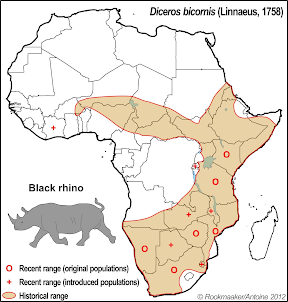Endangered Species Blog 3
Black Rhinoceros
Black Rhinos compared to White Rhinos have a hooked lip and a shorter forehead. They have two horns that grow throughout their lives. The front horn is longer than the rear with an average of 19 inches long. They stand at about 5 feet tall, weighing about 1,760-3,080 pounds. Their current population is about 6,195, with a majority of them living in South Africa, Namibia, Zimbabwe, and Kenya. Because a majority live in these countries, they have become accustomed to shrublands, tropical and subtropical grasslands, montane forests, and savannas.
Black Rhinos are important grazers. They consume large amounts of vegetation - up to 220 different plant species such as shrubs, branches, shoots, fruits, etc. Their consumption helps shape Africa's landscape and not only benefits other animals but also keeps a healthy balance within the ecosystem.
The main reason why Black Rhinos are critically endangered is because of poaching. Rhino horns are poachers' targets. Their horns are sold illegally, used for traditional medicine in mainly Asia, and are status symbols to display success and wealth. These horns can sell for up to $300,000 per horn.
If Black Rhinos were to go extinct, the ecosystem would change drastically. The foliage they usually consume would take over/overgrow. When rhinos eat they make room for other plant species to take root. Without them, invasive plant species would take over and kill off other important plants. Eventually, the land would become barren and forests overgrown. Not only would plants be affect, but also other animals such as Gazelles, Antelopes, and Zebras. On top of all this, there would be less wildlife biodiversity, causing an imbalance in the food change.
To help protect and conserve these creatures, "WWF is working with government agencies, local communities and other partners in Namibia, Kenya, and South Africa to support law enforcement agencies to develop and build on innovative tech solutions, and equip and train rangers to stop poachers." (WWF) A geographer could put tracking tags on some black rhinos to track their movements and to get a better estimate of how many are born or dying.
- adopt and support a rhino- use and support sustainable wood, paper, and palm oil- don't buy rhino horn products- volunteer at a national park or wildlife reserve- report illegal wildlife trade
Sources:https://wwf.panda.org/discover/knowledge_hub/endangered_species/rhinoceros/african_rhinos/#:~:text=They're%20important%20grazers%2C%20consuming,healthy%20balance%20within%20the%20ecosystem.
https://www.worldwildlife.org/species/black-rhino#:~:text=Black%20rhinos%20are%20browsers%2C%20rather,life%20(like%20human%20fingernails).
https://greentumble.com/how-many-rhinos-are-left#:~:text=An%20estimated%20population%20stands%20around,Namibia%2C%20Zimbabwe%2C%20and%20Kenya.
https://www.worldwildlife.org/species/black-rhino#:~:text=Black%20rhinos%20remain%20critically%20endangered,rhinos%20were%20poached%20in%20Africa.
https://mom.com/momlife/248636-things-will-change-when-rhinos-go-extinct/decreased-employment
https://www.worldwildlife.org/species/black-rhino#:~:text=Poaching%20remains%20the%20deadliest%20and,train%20rangers%20to%20stop%20poachers.
Black Rhinos compared to White Rhinos have a hooked lip and a shorter forehead. They have two horns that grow throughout their lives. The front horn is longer than the rear with an average of 19 inches long. They stand at about 5 feet tall, weighing about 1,760-3,080 pounds. Their current population is about 6,195, with a majority of them living in South Africa, Namibia, Zimbabwe, and Kenya. Because a majority live in these countries, they have become accustomed to shrublands, tropical and subtropical grasslands, montane forests, and savannas.
Black Rhinos are important grazers. They consume large amounts of vegetation - up to 220 different plant species such as shrubs, branches, shoots, fruits, etc. Their consumption helps shape Africa's landscape and not only benefits other animals but also keeps a healthy balance within the ecosystem.
The main reason why Black Rhinos are critically endangered is because of poaching. Rhino horns are poachers' targets. Their horns are sold illegally, used for traditional medicine in mainly Asia, and are status symbols to display success and wealth. These horns can sell for up to $300,000 per horn.
If Black Rhinos were to go extinct, the ecosystem would change drastically. The foliage they usually consume would take over/overgrow. When rhinos eat they make room for other plant species to take root. Without them, invasive plant species would take over and kill off other important plants. Eventually, the land would become barren and forests overgrown. Not only would plants be affect, but also other animals such as Gazelles, Antelopes, and Zebras. On top of all this, there would be less wildlife biodiversity, causing an imbalance in the food change.






Comments
Post a Comment